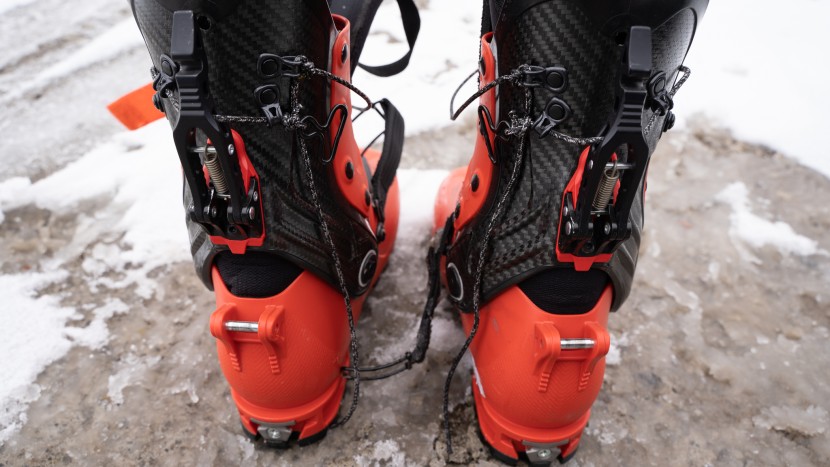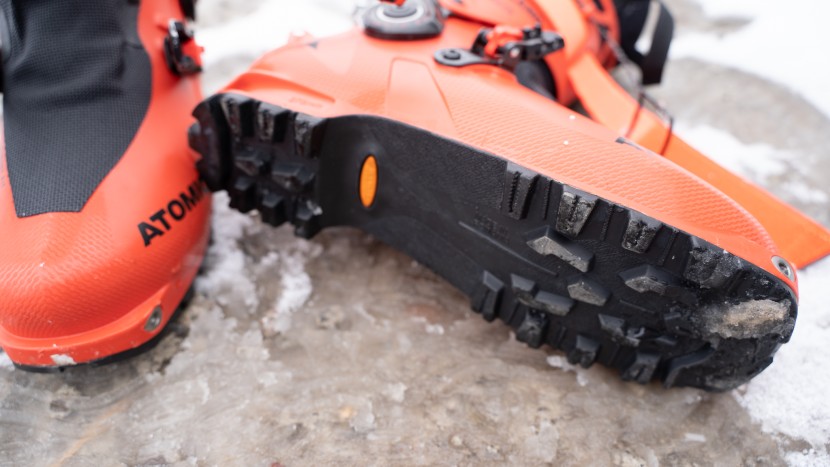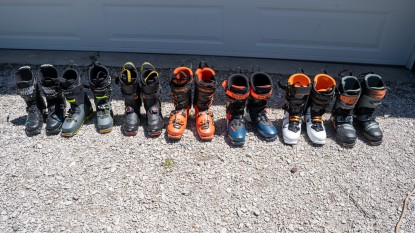Atomic Backland Ultimate Review

Our Verdict
Our Analysis and Test Results
We include the Atomic Backland Ultimate here in this review for its unique positioning in the market. It is a rec-class skimo boot with a full liner. Pro and world cup skimo racers use full carbon boots that are way beyond, in terms of price and specialization, what most people can justify. Next in line are the “training” or recreation class race boots. That is what the Atomic Backland Ultimate is. In that class of boots there are very few that have a full coverage liner. For longer days and true wilderness skiing you really want a full liner. That's what gets the Backland Ultimate into our review. How does it hold up and compare? Read on to find out.
Downhill Performance
You don't pick these for optimum downhill performance. And you won't get optimum downhill performance. If you have been skeptical of lightweight ski gear, however, you might be surprised at how you can adapt to lightweight ski boots. You won't ever shred with these like you can on beefier boots. But you can definitely ski serious, challenging, and fun conditions with the Atomic Backland Ultimate, provided you adjust your technique and match them with suitable skis and bindings.
Uphill Performance
These go uphill like a dream. Of all the boots we have ever reviewed here, the Backland Ultimate has the most freedom of motion within its cuff hinge range. Nothing else in the test roster comes close. The sole is very short for a given size. In order to make them work downhill you will fit them close, even further increasing the uphill nimble feeling. If ski boots can ever feel close to hiking shoes, the Backland Ultimate gets closest.
Weight
On our calibrated digital postal scale we found a single Atomic Backland Ultimate boot to weigh 785 grams. That's 1570 grams for the pair. Or 3 lbs 7 ounces. Of that mass, 619 grams per boot is in the shell and one liner weighs 166 grams. Nothing else in our review competes with the Ultimate. In fact, the heaviest boots in our test are more than twice the mass of this model. In ski boots there is no direct or indirect advantage of weight itself (as opposed to skis. The mass of a ski contributes a great deal of its performance, directly). Of course, the materials that lend stiffness, warmth, and workable flexion all have mass. Heavier boots, indirectly, will ski better than light weight ones. Read on to the downhill performance section to see the cost you pay for incredible low weight and efficient touring mode.
Comfort and Fit
The Atomic Backland Ultimate fits narrow and should be sized close. To get the aforementioned acceptable downhill performance from the light and thin shell that shell must be close to your foot. We downsized considerably. For our lead test editor we took advantage of Atomic's readily molded shell and had professional boot fitting done to optimize the fit. That process of customizing the fit made a big difference. Before the fitting the big toe on his larger foot would end a trip tender and rubbed raw. After the fitting — that didn't involve any specific “punching” — that toe has been free and happy.
Warmth
Close fitting boots made of thin, lightweight materials are not going to insulate very well. After fit (looser fitting boots are warmer) the biggest correlation with ski boot insulation is ski boot weight. Beefier boots are warmer. The Backland Ultimate is not a very insulating boot. Practitioners rely on high tempo travel to keep their feet warm in cold conditions. If you fit these as they are intended to be fit, they aren't the boots you should use for extended avalanche snow pit time, sub zero slow ski tours, or multi-day ski camping outside of the warmest of spring trips.
Ease of Use
We like the “one move” transitions of race style boots. You can now get one move transitions in ski boots that ski a little better than the Backland Ultimate, but we wish that functionality would trickle down further into the range of backcountry ski boots. The buckles of the Backland Ultimate are small and fiddly, but not so much that they really compromise usage. The Backland Ultimate is compatible with automatic crampons but you must use tech bindings only on your skis. The sole provides adequate bare-boot traction, but the lugs are shallow and small, ostensibly to save weight.
Should you buy the Atomic Backland Ultimate?
Only buy these if you know exactly what you are getting into. For skimo racing, they are a great choice and should be compared to other skimo race boots. For true backcountry skiing, these aren't the sort of boots you acquire as your second set of touring boots ever. You likely started in “4 buckle” touring boots. Then maybe you tried out “1 kilo” boots and liked the freedom they allow. If you want even more efficiency than the “1-kilo” boots provide, then you start looking at race class boots. When you are at that point in your search, the Atomic Backland Ultimate is a great choice.
What Other Backcountry Ski Boots Should You Consider?
Commentary on choosing boots for true skimo racing is beyond the scope of what we do here. Consult other sources for that. For light and fast wilderness skiing, the Atomic Backland Ultimate is the lightest thing we recommend. You can reap many of the same advantages by stepping up just a little to the Top Pick Dynafit Mezzalama. The Mezzalama provides the same “one move” transition but is considerably warmer and better for skiing downhill. It is a little heavier and compromises touring efficiency a bit. Another step up in skiing ability from the Mezzalama (and commensurate step down in touring efficiency) is the Editors Choice Scarpa F1 LT. The F1 LT is the lightest boot we recommend people consider for their “quiver of one” selection.
| Awards | |
|---|---|
| Price | $1,150 List Check Backcountry (on sale!) |
Overall Score  |
|
| Star Rating | |
| Bottom Line | Skimo race boots that are suitable for some all-around and fast-and-light ski mountaineering endeavors |
| Pros | Wicked light, close fitting, fast transitions |
| Cons | Only for skiing small skis, slowly |
| Rating Categories | Atomic Backland Ulti... |
| Downhill Performance (35%) | |
| Uphill Performance (20%) | |
| Weight (20%) | |
| Comfort and Fit (10%) | |
| Warmth (10%) | |
| Ease of Use (5%) | |
| Specifications | Atomic Backland Ulti... |
| Weight per Pair (Size 26.5) | 3 lbs 7 oz |
| Binding Compatibility? | Tech only |
| Measured Range of Motion (degrees) | 65° |
| Manufacturer Stated Last Width | 96 mm |
| Weight of One Complete Boot, No Insole | 785 g |
| Weight of One Boot Shell | 619 g |
| Weight of One Stock Liner, No Footbed | 166 g |
| Stated Flex Index | Not Listed |
| Liner Design | Tongue |
| Shell Material | Grilamid |











